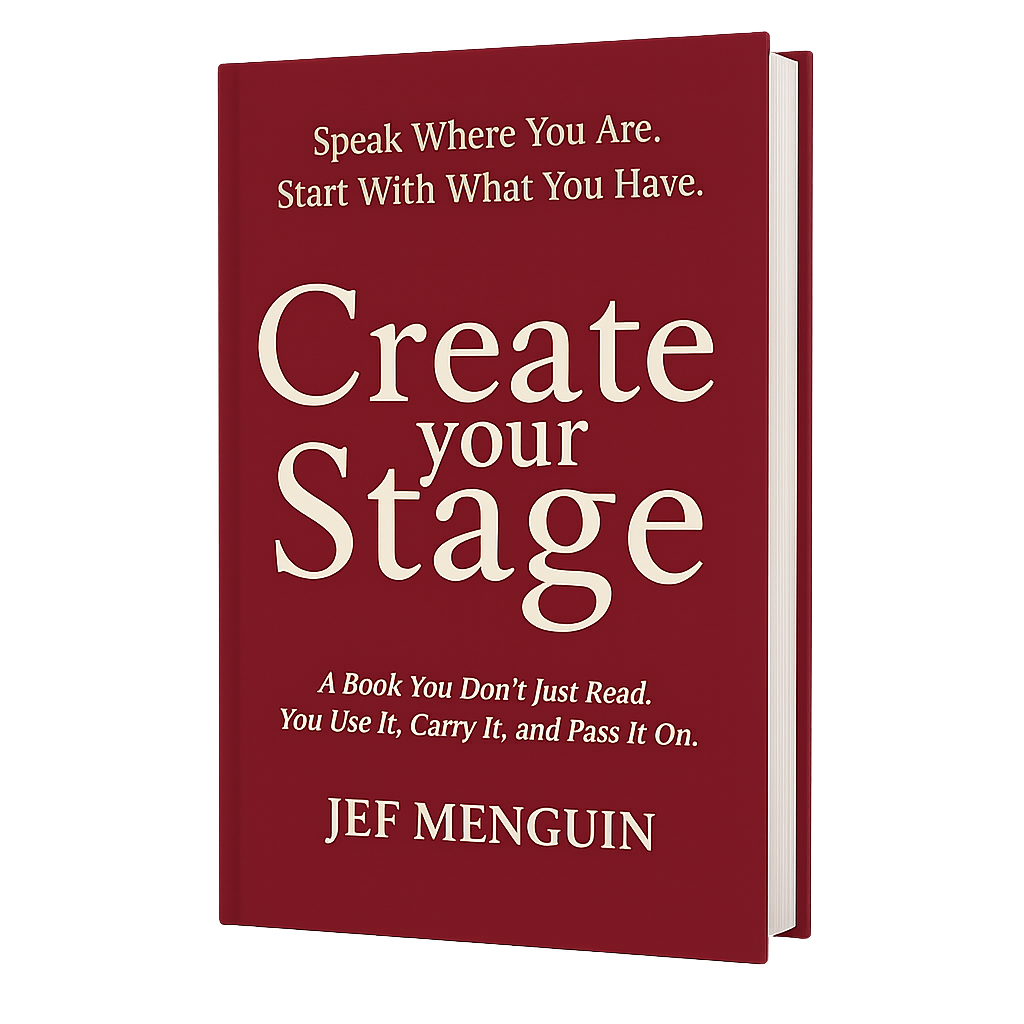Empathy is my secret tool in public speaking. Back in 2004, I joined Toastmasters. At first, I cared a lot about what others thought. Every speech got evaluated. I focused on speaking skills, trying to be the best.
Then I met Vic, who changed my outlook. He said speaking isn’t about showing off. It’s about connecting with your audience. That hit me hard. Suddenly, it wasn’t about me—it was about them.
That changed everything. Now, every word I speak aims to connect with my listeners. Empathy made speaking not just a show, but a meaningful connection.
The Power of Empathy
Empathy isn’t just feeling what others feel. It’s understanding them, right where they are. When we stand up to speak, we’re not just talking to an audience; we’re talking with people. Each one comes with their hopes, fears, and dreams.
You’re at the front, and the crowd is before you. You could fill the air with words, or you could speak to hearts. Empathy turns a speech into a conversation, a lecture into an experience.
Think of the best talks you’ve heard. Weren’t they the ones where you felt the speaker was talking right to you? That’s empathy at work. It is a simple, honest connection.
As we dive into the ten big wins of bringing empathy into your public speaking, remember this: it’s about making each word count, each moment matter.
Empathy helps you understand, connect, and transform a room of individuals into a unified audience, nodding and thinking, “Yes, I get it.” That’s the power of empathy.
1. Build a Strong Connection with the Audience
Empathy starts with walking in their shoes. Imagine a room full of people with stories, worries, and dreams. Your job? Connect with those stories.
Let’s say you’re talking about change. Don’t just talk about change in the air. Talk about the change they feel. The change that keeps them up at night. That’s where empathy starts.
Speak to their experiences. Not in broad strokes, but in real ways. “I know you’re worried about what’s next. I’ve been there too.” See, now you’re not a speaker; you’re a friend. You’re someone who gets it.
To me, public speaking is another way of saying I was where you are today, and yes, I do understand you. At times, it may also mean an acceptance that though you’ve not been where they are, you had a similar experience.
You show empathy through your actions. Your tone, your gaze, the way you stand. All of it says, “I’m with you, not above you.” That’s the connection. It’s not about impressing them; it’s about impressing upon them that you understand.
When they feel that you get them, they listen. Really listen. Not because they have to, but because they want to. They lean in. They engage. And that’s the moment when your words stop being just words. They become a bridge. A bridge that connects your message to their hearts.
2. Enhance Audience Engagement
Start by asking, “What’s in it for them?” Every person in that room has a reason to listen. Find it. Address it. Maybe it’s a solution they’re after, or an insight, or just a story that makes their day better. Your job is to deliver that.
Use their language, not yours. Drop the jargon. Speak in words that resonate with them, words that are friendly, and familiar. It’s like choosing the right key for a song – the one that lets everyone sing along.
Tell stories that mirror their experiences, that reflect their struggles, and their victories. When they see themselves in your story, they’re no longer just listening; they’re living it. And when they live it, they remember it.
Ask questions. Not rhetorical questions, but real ones. “Have you ever felt like this?” “What would you do?”
Public speaking isn’t a monologue; it’s a conversation. And in a conversation, everyone gets a turn.
Empathy lets you read the room. You see the bored faces, the eager nods. Adjust on the fly. If they’re drifting, reel them back in. If they’re excited, build on that energy.
Engagement is about creating moments. Moments of understanding, of revelation, of laughter, and maybe even of tears. It’s about creating a journey that you and your audience take together, each step fueled by empathy.
Engagement makes you leave your audience better than you found them. More informed, more inspired, more connected. And that’s the true measure of a speech’s success – not just in what you say, but in how you make them feel. That’s engagement, and it starts and ends with empathy.
3. Facilitate Clearer Communication
Clarity in speaking is more than just being understood. Make sure your message lands right where it should. That’s where empathy shines.
Think of it this way: your audience is on the other side of a river. You need to build a bridge for your ideas to cross. Empathy is your toolbox. You’re not just throwing words; you’re building a pathway for understanding.
Start by knowing their background. What do they know? What don’t they know? This isn’t about dumbing down; it’s about tuning your message to their frequency. Like a radio station that comes in clear when you’re on the right channel.
Use examples that resonate with them. If you’re talking to teachers, use classroom stories. If it’s entrepreneurs, talk about the startup hustle. It’s like putting your message in a setting they know and feel comfortable in.
But here’s the tricky part: avoid assumptions. Don’t guess their feelings or experiences. Instead, ask questions before you speak. Do a little homework. It shows respect, and it clears the fog for both of you.
Simplicity is key. Big words might sound impressive, but they often cloud the message. Use simple, direct language. It’s like using a straight, well-lit road instead of a winding, foggy path.
Remember, empathy in communication isn’t just about the words you choose. It’s about noticing when they’re confused and slowing down. It’s about seeing their nods and speeding up. It’s a dance, and you’re both on the dance floor.
And finally, listen. Really listen. Not just for a pause to jump in, but to understand. Sometimes, what they don’t say speaks volumes about what your next words should be.
4. Improve Speaker Credibility
Credibility isn’t just earned by what you know; it’s also how you connect with what they feel. That’s where empathy makes all the difference. It’s not just about facts; it’s about trust.
First, remember: People trust those who understand them. When you show that you get their challenges, their fears, and their hopes, you’re not just a speaker. You become a voice they can believe in.
Be genuine. Share your failures, not just your victories. It’s easy to relate to someone who’s been through the ups and downs and is open about it. It’s like saying, “I’m one of you.”
Listening is as important as speaking. When you listen to their questions and concerns, you’re showing respect. And respect is a cornerstone of trust.
It’s okay not to have all the answers. Admitting that you don’t know something can actually boost your credibility. It shows you’re honest. And honesty is magnetic.
Show empathy in your actions. Follow up on promises. If you say you’ll get back to them with an answer, do it. Actions speak louder than words, and they echo longer.
Consistency is your friend. Be consistent in your message and your values. People trust a compass that points true north. Be that compass.
Remember, credibility isn’t just built in a day or a single speech. It’s built over time, through each interaction, each display of understanding and respect. It’s a journey. And on this journey, empathy is your guide.
5. Enable Effective Handling of Feedback
Feedback, the give-and-take after your speech, is where empathy shows its strength. Feedback is not just about responding to questions or comments. It’s about understanding and addressing what’s behind them.
First up, listen. Not just to the words, but to the emotions and concerns beneath them. Sometimes, a question isn’t just a question; it’s a doubt, a worry, or even an unspoken need.
Welcome feedback, even the tough stuff. When someone challenges your points, see it as an opportunity, not a threat. It’s a chance to deepen the conversation, and to see things from another angle.
Here’s a tip: Repeat or rephrase their questions or comments. It shows you’re listening and gives you a moment to think. Plus, it ensures you’ve got it right. Misunderstanding can lead to miscommunication.
Empathy means respecting their viewpoint, even if you disagree. Acknowledge their perspective before presenting your own. It’s like saying, “I see where you’re coming from,” and then gently guiding them to see your side.
Be honest, but gentle in your responses. If you don’t know, say so. If they’ve made a good point, acknowledge it. Honesty builds trust, and trust opens ears.
Remember, feedback isn’t a one-way street. It’s a dialogue. So, ask questions in return. Encourage them to elaborate. It shows you’re engaged and interested.
And finally, keep your cool. Emotions can run high in these exchanges. Stay calm, stay respectful. Your demeanor sets the tone. And a calm, empathetic tone can turn even a heated debate into a constructive conversation.
Handling feedback with empathy turns what could be a confrontational moment into a collaborative one. It’s not about defending your turf; it’s about expanding understanding, theirs and yours. And in that expanded understanding, you grow – as a speaker, as a listener, and as a person.
6. Increase Persuasiveness
Empathy is a powerful tool in persuasion. It’s not about manipulating emotions; it’s about aligning your message with the audience’s needs and viewpoints. Here’s how empathy makes your arguments more convincing.
First, understand their perspective. What are their beliefs, concerns, or objections? When you know where they stand, you can tailor your message to resonate with them.
Show them you get it. Use phrases like, “I understand why you might think that,” or “It’s natural to feel that way.” This validation opens doors. People are more receptive to ideas when they feel understood.
Use stories and examples that echo their experiences. When they can see themselves in your narrative, your points hit home harder. It’s like painting a picture where they are the main characters.
Anticipate their objections. Think two steps ahead. Address their concerns before they voice them. It shows you’ve thought things through from their side, too.
Be genuine. Empathy in persuasion is not about trickery. It’s about connecting your message to their values and needs. If they sense insincerity, the bridge collapses.
Balance logic with emotion. Facts and figures are important, but so are stories and emotions. A blend of both speaks to the head and the heart.
Don’t leave them hanging. Give them a clear, empathetic reason to act. “I know this change seems big, but think of the impact it can have on your daily work.”
Remember, persuasion is not just about winning an argument; it’s about winning hearts and minds. And at the heart of that victory is empathy. It’s the difference between talking at them and talking with them, between a monologue and a dialogue.
7. Adapt to Diverse Audiences
Empathy shines brightest when it comes to speaking to diverse groups. It’s about understanding and respecting the unique perspectives and backgrounds of your audience. Here’s how empathy helps you adapt your message for everyone.
Recognize the diversity. Each audience is a mosaic of different experiences, cultures, and beliefs. Acknowledge this diversity upfront. It’s like saying, “I see all of you, and I value all of you.”
Before you speak, learn about the group you’re addressing. What are their common interests, cultural backgrounds, or industry specifics? Knowledge shows respect, and respect is the foundation of empathy.
Adjust your examples and references. Make sure they’re inclusive and relatable to your audience. It’s like changing the settings in a story so that everyone feels part of it.
Be mindful of language. Avoid jargon, slang, or references that might not translate well across different cultures or demographics. Clarity is inclusive.
If there’s a Q&A session, pay attention to the concerns and questions raised. They’re clues to their perspectives, and addressing them shows you care.
Be flexible in your delivery. Watch for reactions. Are they engaged or confused? Ready to laugh or more serious? Adapt your tone and content on the fly. It’s a dance, and you need to move with your partner, the audience.
And here’s something important: Empathy is not just about what you say; it’s also about what you don’t say. Steer clear of stereotypes or assumptions. They’re not just harmful; they’re barriers to real connection.
Remember, adapting to diverse audiences is not about losing your message; it’s about expanding its reach. It’s about ensuring that no matter who’s in the room, they feel seen, heard, and valued. That’s the power of empathy. It doesn’t just cross barriers; it breaks them down. And in their place, it builds bridges of understanding. That’s how you turn a diverse audience into a unified one.
8. Craft Impactful Stories
Stories are the heartbeat of effective public speaking, and empathy is what gives them life. Here’s how using empathy helps you craft stories that not only captivate but also connect deeply with your audience.
First, understand their journey. What experiences do your listeners share? What challenges or triumphs can they relate to? Your stories should reflect these common threads.
Make your characters relatable. Whether it’s a personal anecdote or a fictional tale, the characters should mirror the audience’s fears, hopes, or dreams. It’s like holding up a mirror where they see a bit of themselves.
Use emotions wisely. The best stories evoke feelings. Joy, sorrow, surprise, or inspiration – choose emotions that resonate with your audience. It’s about touching their hearts to move their minds.
Keep it authentic. Authenticity breeds connection. Even if you’re using a metaphor or a parable, the underlying emotions and lessons should be genuine. It’s the difference between a story that’s heard and one that’s felt.
Involve the senses. Describe not just the events, but how they look, sound, and feel. This sensory detail draws listeners into the story, making it a shared experience.
But here’s the key: tailor the story to the setting. A story for a room of executives might differ from one for a group of college students. It’s the same story, but the angles and details shift to meet them where they are.
And remember, stories are two-way streets. They’re not just about you telling; they’re about the audience receiving. Watch their reactions, and be ready to adapt. Maybe they need more context, or perhaps a lighter touch.
Finally, make your story lead somewhere. What’s the takeaway? Every story should have a point, a moment of revelation that your audience can carry with them. It’s like leaving a breadcrumb trail that leads to a larger message.
In crafting stories with empathy, you’re doing more than sharing a narrative; you’re creating an experience. An experience that doesn’t just inform or entertain, but one that resonates on a deeply human level. That’s the power of a well-told story. It doesn’t just speak; it echoes in the hearts and minds of your listeners.
9. Promote Cultural Sensitivity
Cultural sensitivity in public speaking is essential. Empathy is the key to navigating this landscape. It’s about respecting and understanding the varied tapestries of culture in your audience.
Start by acknowledging diversity. Recognize and celebrate the different cultural backgrounds in your audience. It’s a way of saying, “I see you, and I value where you come from.”
Do your homework. Before you speak, learn about the cultural norms and values of your audience. What might be considered respectful or offensive? Knowledge here is not just power; it’s respect.
Use inclusive language. Avoid idioms, phrases, or references that might be misunderstood or alienating. Simple, clear language is the bridge that connects diverse cultures.
Be aware of non-verbal cues. Gestures, eye contact, and body language can vary significantly across cultures. What’s friendly in one culture might be offensive in another.
Stay open and adaptable. If you’re informed that something you said or did isn’t culturally appropriate, don’t get defensive. Learn, apologize if necessary, and adapt. It shows humility and respect.
Here’s an important point: cultural sensitivity is not about walking on eggshells. It’s about walking with awareness and respect. It’s about understanding that the tapestry of human experience is vast and varied, and every thread has its color and texture.
And remember, cultural sensitivity is not just about avoiding missteps. It’s about actively seeking to understand and connect with people from different cultural backgrounds. It’s an ongoing process, a journey of learning and growing.
Promoting cultural sensitivity in your public speaking is about building bridges. Bridges that span across differences to find common ground. It’s about creating a space where everyone, regardless of their cultural background, feels respected and heard. That’s not just effective public speaking; that’s effective human connection.
10. Foster Long-Term Relationships
Empathy in public speaking isn’t just about the moment of speech; it’s about creating lasting connections. Long-term relationships with your audience go beyond the applause. Here’s how empathy helps you build these enduring ties.
First, it’s about remembering that each speech is a conversation, not a monologue. You’re starting a dialogue that can continue long after you step off the stage. View each speaking opportunity as a chance to begin a relationship.
Follow up. If there’s a way to keep the conversation going after your talk, do it. Whether it’s through social media, a newsletter, or a simple Q&A session. It shows that you’re interested in them, not just in being heard.
Be consistent in your messaging. People are drawn to speakers who stick to their values and message. It creates a sense of trust and reliability. Think of it as building a brand of you.
Show that you care about their progress or how they implement your ideas. Offer resources, advice, or follow-up content that can help them. It’s not just about what you say on stage; it’s about how you can be of service off stage.
Here’s a key: Listen to their stories. When members of your audience share their experiences or how your speech impacted them, listen. Engage with their stories. It makes them feel valued and deepens the bond.
And don’t forget to evolve. As you grow and learn, so should your speaking. Your audience will appreciate your journey of growth and will often grow with you.
Remember, fostering long-term relationships through public speaking is about creating a community. A community that’s built on mutual respect, understanding, and a shared journey. Each speech is a seed planted, and with empathy, those seeds can grow into a forest of connections.
Master Extemporaneous Speaking
Speak extemporaneously. It helps you connect with your audience much better. Here are some tips to help you master extemporaneous speaking.
Conclusion
Empathy in public speaking is more than a skill; it’s a pathway to genuine connection. It transforms words into bridges, speeches into dialogues, and audiences into communities. From building strong connections to fostering long-term relationships, empathy is the golden thread that weaves through every aspect of effective communication.
At its heart, public speaking is about sharing a part of yourself – your ideas, stories, and visions. When you infuse empathy into this sharing, you’re not just speaking; you’re resonating. You’re not just informing; you’re inspiring. And you’re not just being heard; you’re being felt and remembered.
In a world where attention is fragmented and genuine connection is rare, empathy is your beacon. It guides your words, shapes your stories, and anchors your message in the hearts and minds of your audience.
So, as you step onto that stage, remember that your words have the power to change perspectives, touch lives, and move hearts. Use empathy to wield this power with care, respect, and understanding. Because when you do, you’re not just a speaker; you’re a force for positive change, a voice that echoes far beyond the final applause.
The true measure of your success as a speaker isn’t just in the applause you receive, but in the connections you build, the understanding you foster, and the impact you leave behind. That’s the empathy factor in public speaking, and it’s what turns a good speaker into an unforgettable one.
Speak Like A Leader
You can train your managers and supervisors to speak like a leader. I can help you speak with empathy. To speak is to change the world. People won’t let you change their world unless they know you care.
When you need help in developing managers who speak like leaders, schedule a discovery session. I will help you.






